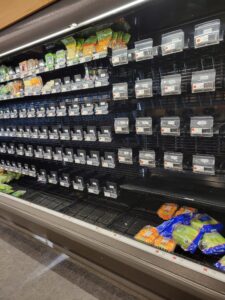Food Inflation: What the Future Holds and How You Can Prepare

At Extreme Investor Network, we strive to provide our readers with timely and unique insights into economic trends, especially those that affect your everyday life. Recently, discussions around food inflation have surfaced again, highlighting the continuous strain on consumer wallets. In this blog, we dive into the challenging landscape of food prices while offering actionable tips to help you navigate these turbulent times.
What Does the Future Hold for Food Prices?
Our predictive models indicate that food inflation is unlikely to ease by 2025. The stark reality is that several factors will continue to impact prices, including adverse weather events and persistent supply chain shortages. One alarming prediction suggests a severe drought is likely to hit the U.S. and Canada between 2025 and 2027—echoing existing conditions that have already begun to emerge.
As a savvy investor, it’s crucial to stay ahead of these trends. Stockpiling food over the next two years could provide both a buffer against rising costs and a safeguard for your family’s food security.
Insights from Industry Leaders
Walmart’s CEO, Doug McMillon, recently voiced his concerns over the food industry, indicating persistent high prices at the grocery store. "I don’t know what the whole year is going to look like," he said, expressing disappointment over current food inflation, notably in staples like eggs and dairy. These kinds of insights from industry leaders underscore a broader economic trend that few can ignore.
Understanding the Broader Economic Landscape
Food prices escalated dramatically during the pandemic and have yet to stabilize. The fallout from the conflict in Ukraine exacerbated these issues, severely affecting Europe’s food supply chain. According to a recent study by the Food Industry Association, food inflation in the U.S. has surged by 25% since the onset of the pandemic, with a recent monthly rise of 1.1% in November.
But the story doesn’t stop there. Environmental policies aimed at climate change have led to reduced farmland and cattle raising, as advocates claim that reducing meat consumption is imperative for lowering our carbon footprint. This evolving landscape will have far-reaching consequences for food production and availability.
The Influence of Tariffs
Tariffs are another critical factor at play. Historically known for their inflationary effects, they have consistently burdened consumers rather than providing relief. The potential for additional tariffs to disrupt supply chains could further exacerbate the pricing crisis, impacting everything from supermarkets to specialty grocery stores.
Central banks, while acknowledging that inflation has moderated in some sectors, seem indifferent to the ongoing challenge of food costs—one of the most vital economic indicators affecting everyday citizens.
How You Can Prepare
Given these intertwined factors, preparation is key. Here are some strategies to consider:
-
Stockpile Non-perishables: Take advantage of sales to build a stock of non-perishable food items. Focus on essentials like rice, pasta, canned goods, and legumes that have a long shelf life.
-
Explore Alternative Markets: Consider buying directly from local farmers or joining community-supported agriculture (CSA) programs. This not only ensures fresher produce but also helps support local economies.
-
Plan Your Meals: Meal planning can significantly reduce food waste and promote smarter shopping habits. By knowing what to buy and when to use it, you can better manage your grocery budget.
-
Stay Informed: Follow economic news and forecasts. Websites like Extreme Investor Network provide valuable insights that can help you anticipate market shifts and prepare accordingly.
- Diversify Investments: If you’re looking at investments, consider commodities and agricultural stocks that may benefit in a rising price environment.
In conclusion, the future of food inflation is uncertain, but one thing is clear: being proactive can make all the difference. At Extreme Investor Network, we are committed to equipping you with the tools and knowledge to navigate economic fluctuations. Stay informed, stay prepared, and let’s face the future together.

